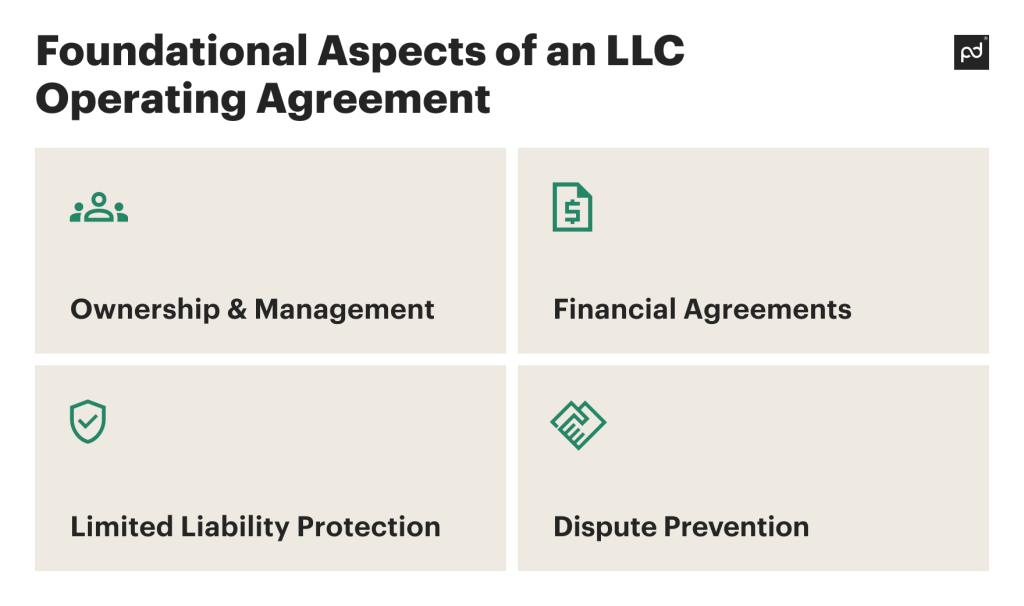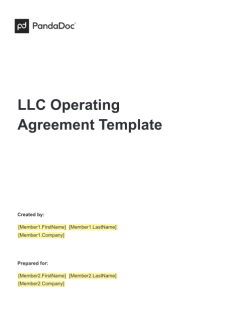Drafting an LLC operating agreement may feel intimidating. But it doesn’t have to.
Limited liability companies (LLCs) are the preferred business structure for SMBs, with over 3.2 million LLCs in operation, according to the IRS.
And even though most states don’t require an operating agreement for an LLC to exist, it always makes good business sense to have one in place.
In this article, we’ll show you exactly how to write an operating agreement for your LLC, the sections to include according to your business entity, and how the process is made easier with customizable templates already formatted for each state.
What is an LLC operating agreement?
An LLC operating agreement is a legally binding internal document that outlines the ownership structure, member roles, and operational guidelines for a limited liability company.
As the name makes clear, a limited liability company (LLC) is a flexible business structure that provides its members with limited personal liability protection — the members’ personal assets are separated from the company’s debts and liabilities by design, which enables members (the owners) to better manage risk.
The LLC operating agreement details how rules and responsibilities — such as voting rights and stakeholder duties — shall be distributed among the managing business owners, and includes basic information about the LLC and its owners.
Do you need an operating agreement for your LLC?
As we mentioned above, most states in the US don’t require an operating agreement.
Currently, California, Delaware, Maine, Missouri, and New York are the only exceptions — but always check with your state’s current LLC laws concerning operating agreements to ensure full compliance.
While it may not be required where you set up shop, here are a few reasons why it’s a good idea to have an operating agreement for your LLC:
- Defines ownership and management: clearly outlines ownership percentages and management roles.
- Clarifies financial agreements: outlines financial contributions, distributions, and accounting practices.
- Protects limited liability: reinforces the LLC’s status as a separate, distinct legal entity.
- Prevents disputes: establishes procedures for handling disagreements and making decisions, avoiding costly legal battles.
- Customizes arrangements: allows for tailored business operations and profit distributions.
- Overrides default rules: replaces state default rules (which will govern your LLC in the absence of an operating agreement) with your own customized guidelines.
- Enhances credibility: demonstrates professionalism to banks, investors, and third parties.
- Provides continuity: ensures smooth operation during changes in membership or management.
- Facilitates succession planning: details procedures for transferring ownership and handling the departure of members.

What happens if you don’t have an operating agreement?
If you don’t have an operating agreement in place, roles, responsibilities, decision-making, and liability protection are either unclear or weakened.
For example, If your company lacks an operating agreement and you are sued for causing financial loss, the court might hold you personally liable instead of your company.
A written operating agreement specifying that the company covers damages incurred by its managing member could prevent this personal liability.
And it’s not just protection from lawsuits we’re talking about. Imagine having to meet every time you need to make a decision on matters like these:
- How much more funds has a particular managing member contributed than what was agreed upon?
- How should losses be shared among the managing members?
- When should the company pay distributions to its managing members, and how much should each receive?
- Should the company cover the business trip costs of a managing member?
- Can a managing member use the company’s money, and for what purpose?
- Where should all company documents be stored?
These are just a few of the reasons why having an operating agreement for your LLC is a wise choice, even if your state laws don’t require it.
How to write an operating agreement — step by step
Whether you’re launching a single-member LLC or a multi-member LLC, legal documents like operating agreements can seem daunting.
Writing one from scratch can lead to:
- Omitting essential articles
- Using ambiguous terms
- Inadequately elaborating on terms and conditions
These mistakes can have serious consequences if the agreement is contested.
Thankfully, most agreements, including LLC operating agreements, have key sections that remain consistent across organizations — and this is where customizable templates come in to save the day.
Let’s go over the steps to complete a standard LLC operating agreement, one you can adjust or modify to meet your specific needs.

LLC Operating Agreement Template
Used 4872 times
Streamline operations to ensure you’re running your business smoothly with a free LLC Operating Agreement Template.
Use this templateBasic company details
Start by detailing the foundational information about your company. Include the LLC’s name, formation date, primary business address, governing state laws, and primary business purpose. This sets the groundwork for your LLC’s identity and legal compliance.
Determine ownership percentages
Outline how member interests are determined based on their capital contributions.
Clearly specify each member’s ownership percentage and initial contributions to avoid future disputes.
Designate rights, responsibilities, and compensation
This section forms the backbone of your LLC operating agreement:
- Explain the management structure and designate roles and duties.
- Clarify that members manage the business and affairs, but no member has the authority to bind the company without written consent from the other members.
- Detail the appointment of managers, provisions for creating committees, and voting rights to ensure a well-organized management structure.
- Specify how profits and losses will be distributed among members to set clear expectations.
Liability protection
Provide members with limited liability protection, keeping their personal assets separate from the LLC’s debts, liabilities, and legal obligations.
Clearly define this protection to reduce potential legal disputes and ensure members understand their rights, responsibilities, and obligations.
Define the terms of joining or leaving
Require majority approval from existing members to admit new members, setting terms and conditions, including capital contributions.
With respect to leaving the operating agreement, allow members to withdraw with 60 days’ written notice and specify how interests can be transferred to heirs or others in cases of death or disability.
This ensures a smooth transition and clarity in membership changes.
Create dissolution terms
This provision specifies what to do once the company ceases to exist.
Outline the conditions under which the LLC will dissolve, such as written consent of the members, a member’s departure, death, or disability, or other legal events.
Detail how the company’s assets will be liquidated and distributed among members according to their interests to ensure an orderly wind-up process.
Insert a severability clause
Include a severability clause to ensure that if any part of the agreement is deemed invalid, the remaining provisions will still be enforceable.
This protects the integrity of the operating agreement.
Establish dispute resolution procedures
Resolve contract disputes and disagreements through arbitration, following the American Arbitration Association’s rules.
Specify that arbitration will take place in the company’s city and state unless members agree on an alternative location, and the arbitrator’s award can be entered into a court with jurisdiction.
Include compliance and record-keeping requirements
Detailed compliance and record-keeping are essential for your LLC to thrive.
Maintain accurate financial records per accepted accounting principles, using the calendar year as the fiscal year unless otherwise agreed.
Allow members to inspect books and records with reasonable notice.
Miscellaneous provisions
Finally, be sure to include any other necessary or applicable provisions, such as governing law and jurisdiction, to ensure comprehensive coverage of all aspects of the agreement.
Operating agreements made easy
With the guidance above and the templates at your disposal, writing your LLC operating agreement will be as comprehensive as it is easy to execute.
PandaDoc is here to help. We’ve got operating agreements by type as well as templates for every state. Start a free trial to learn more.
Disclaimer
PandaDoc is not a law firm, or a substitute for an attorney or law firm. This page is not intended to and does not provide legal advice. Should you have legal questions on the validity of e-signatures or digital signatures and the enforceability thereof, please consult with an attorney or law firm. Use of PandaDoc services are governed by our Terms of Use and Privacy Policy.
Originally published November 24, 2021, updated August 16, 2024
Frequently asked questions
-
LLCs are only required to have an operating agreement in five states: California, Delaware, Maine, Missouri, and New York.
-
No. Even though some states require you to have an operating agreement, you’re not obliged to file it publicly with the state.
-
An operating agreement can protect you, as a managing LLC member, from personal liability if the company is responsible for financial damage.
-
Yes. The operating agreement is a standard document. You can find many examples and templates on the internet. PandaDoc has an operating agreement template for multi-member LLCs.


